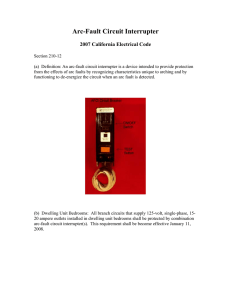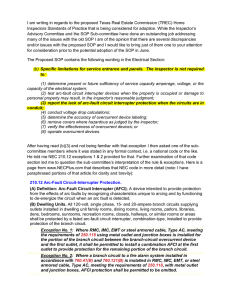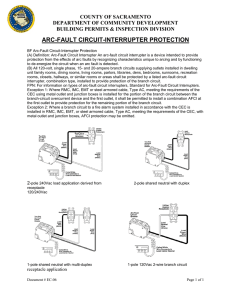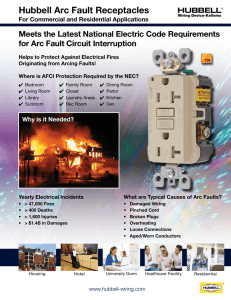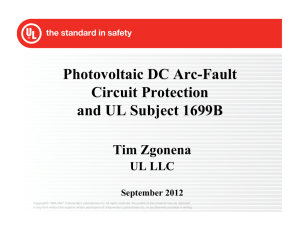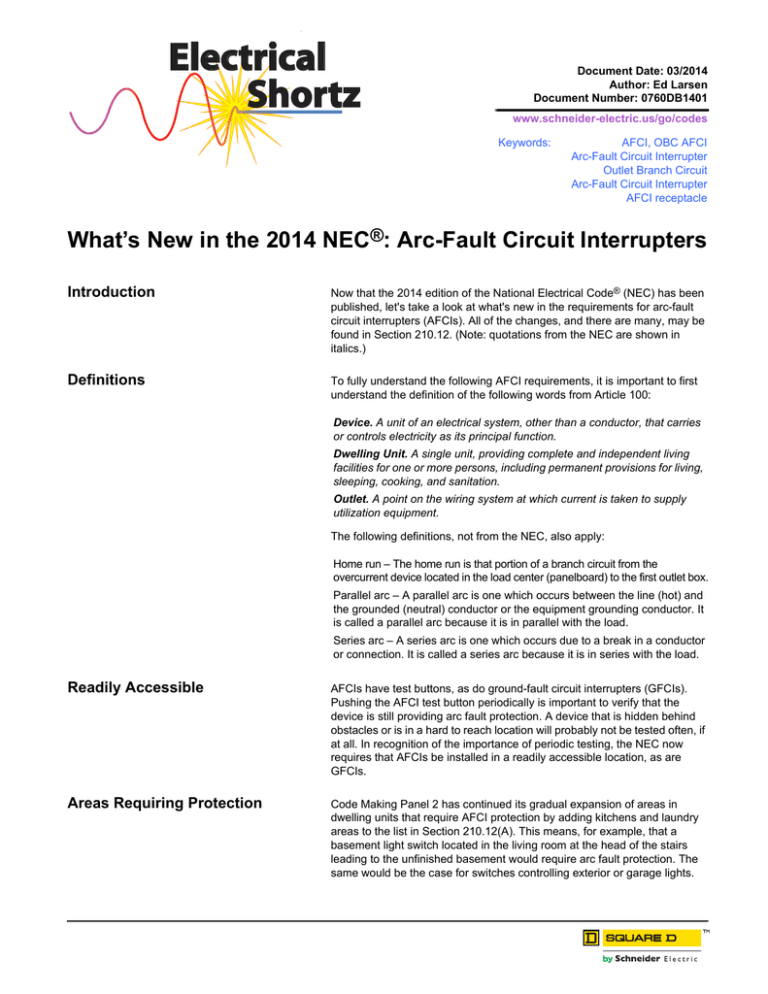
Electrical
Shortz
Document Date: 03/2014
Author: Ed Larsen
Document Number: 0760DB1401
www.schneider-electric.us/go/codes
Keywords:
AFCI, OBC AFCI
Arc-Fault Circuit Interrupter
Outlet Branch Circuit
Arc-Fault Circuit Interrupter
AFCI receptacle
What’s New in the 2014 NEC®: Arc-Fault Circuit Interrupters
Introduction
Now that the 2014 edition of the National Electrical Code® (NEC) has been
published, let's take a look at what's new in the requirements for arc-fault
circuit interrupters (AFCIs). All of the changes, and there are many, may be
found in Section 210.12. (Note: quotations from the NEC are shown in
italics.)
Definitions
To fully understand the following AFCI requirements, it is important to first
understand the definition of the following words from Article 100:
Device. A unit of an electrical system, other than a conductor, that carries
or controls electricity as its principal function.
Dwelling Unit. A single unit, providing complete and independent living
facilities for one or more persons, including permanent provisions for living,
sleeping, cooking, and sanitation.
Outlet. A point on the wiring system at which current is taken to supply
utilization equipment.
The following definitions, not from the NEC, also apply:
Home run – The home run is that portion of a branch circuit from the
overcurrent device located in the load center (panelboard) to the first outlet box.
Parallel arc – A parallel arc is one which occurs between the line (hot) and
the grounded (neutral) conductor or the equipment grounding conductor. It
is called a parallel arc because it is in parallel with the load.
Series arc – A series arc is one which occurs due to a break in a conductor
or connection. It is called a series arc because it is in series with the load.
Readily Accessible
AFCIs have test buttons, as do ground-fault circuit interrupters (GFCIs).
Pushing the AFCI test button periodically is important to verify that the
device is still providing arc fault protection. A device that is hidden behind
obstacles or is in a hard to reach location will probably not be tested often, if
at all. In recognition of the importance of periodic testing, the NEC now
requires that AFCIs be installed in a readily accessible location, as are
GFCIs.
Areas Requiring Protection
Code Making Panel 2 has continued its gradual expansion of areas in
dwelling units that require AFCI protection by adding kitchens and laundry
areas to the list in Section 210.12(A). This means, for example, that a
basement light switch located in the living room at the head of the stairs
leading to the unfinished basement would require arc fault protection. The
same would be the case for switches controlling exterior or garage lights.
What’s New in the 2014 NEC®: Arc-Fault Circuit Interrupters
Electrical Shortz
New Installations
0760DB1401
03/2014
Section 210.12(A) now lists six different ways to comply with the
requirement to provide AFCI protection in specific dwelling unit areas. It is
important to note that all of these methods are intended to protect the entire
branch unit, in addition to cords plugged into it.
1. Combination-type AFCI circuit breaker:
(1) A listed combination-type arc-fault circuit interrupter, installed to
provide protection of the entire branch circuit.
This is the method that has been used for the past several years to meet
the AFCI requirement in this section.
2. Branch/feeder-type AFCI circuit breaker + outlet branch circuit-type
AFCI receptacle:
(2) A listed branch/feeder-type AFCI installed at the origin of the
branch-circuit in combination with a listed outlet branch-circuit type
arc-fault circuit interrupter installed at the first outlet box on the
branch-circuit. The first outlet box in the branch circuit shall be marked
to indicate that it is the first outlet of the circuit.
The concept in this requirement is that:
a. The branch/feeder-type AFCI circuit breaker located in the load
center will protect the home run from parallel arcing.
b. The outlet branch-circuit type arc-fault circuit interrupter (OBC AFCI)
located in the first outlet box will protect the downstream conductors
and any cords plugged into its face from both series and parallel
arcing.
c. The OBC AFCI will also provide series arc protection for the home
run.
The purpose of marking the first outlet box at the time of rough-in is to
insure that the OBC AFCI gets installed in it at a later time.
3. Supplemental arc protection circuit breaker + outlet branch circuit-type
AFCI receptacle:
(3) A listed supplemental arc protection circuit breaker installed
at the origin of the branch circuit in combination with a listed
outlet branch-circuit type arc-fault circuit interrupter installed
at the first outlet box on the branch circuit where all of the
following conditions are met:
a. The branch-circuit wiring shall be continuous from the branchcircuit overcurrent device to the outlet branch-circuit arc-fault
circuit interrupter.
b. The maximum length of the branch-circuit wiring from the
branch-circuit overcurrent device to the first outlet shall not
exceed 15.2 m (50 ft) for a 14 AWG conductor or 21.3 m
(70 ft) for a 12 AWG conductor.
c. The first outlet box in the branch-circuit shall be marked to
indicate that it is the first outlet of the circuit.
The concept in this requirement is that:
a. The supplemental arc protection circuit breaker located in the load
center will protect the home run from parallel arcing. But in order
for it to do so there must be sufficient arcing fault current to cause
the circuit breaker to trip instantaneously, therefore, the home run
may not exceed 50 ft for 14 AWG and 70 ft for 12 AWG
conductors.
b. The OBC AFCI located in the first outlet box will protect the
downstream conductors and any cords plugged into its face from
both series and parallel arcing.
2
© 2014 Schneider Electric All Rights Reserved
0760DB1401
03/2014
What’s New in the 2014 NEC®: Arc-Fault Circuit Interrupters
Electrical Shortz
c. The OBC AFCI will also provide series arc protection for the home
run.
The purpose of marking the first electrical box at the time of rough-in is
to insure that the OBC AFCI gets installed in it at a later time. Requiring
the home run to be continuous insures that all downstream conductors
will be protected by the OBC AFCI.
It should be noted that at the time of this writing Underwriters
Laboratories® (UL®) has yet to issue an Outline of Investigation for
supplemental arc protection circuit breakers, nor are any known to be on
the market.
4. System combination-type AFCI
(4) A listed outlet branch-circuit type arc-fault circuit interrupter installed
at the first outlet on the branch circuit in combination with a listed
branch-circuit overcurrent protective device where all of the following
conditions are met:
a. The branch-circuit wiring shall be continuous from the branch-circuit
overcurrent device to the outlet branch-circuit arc-fault circuit
interrupter.
b. The maximum length of the branch-circuit wiring from the branch-circuit
overcurrent device to the first outlet shall not exceed 15.2 m (50 ft) for a
14 AWG conductor or 21.3 m (70 ft) fo.r a 12 AWG conductor.
c. The first outlet box in the branch circuit shall be marked to indicate
that it is the first outlet of the circuit.
d. The combination of the branch-circuit overcurrent device and outlet
branch-circuit AFCI shall be identified as meeting the requirements
for a system combination-type AFCI and shall be listed as such.
The concept in this requirement is that:
a. The branch-circuit overcurrent device (circuit breaker) located in
the load center will protect the home run from parallel arcing. But
in order for it to do so there must be sufficient arcing fault current
to cause it to open instantaneously, therefore, the home run may
not exceed 50 ft for 14 AWG and 70 ft for 12 AWG conductors.
b. The OBC AFCI located in the first outlet box will protect the
downstream conductors and any cords plugged into its face from
both series and parallel arcing.
c. The OBC AFCI will also provide series arc protection for the home
run.
d. Testing the branch-circuit overcurrent device and OBC AFCI
together and listing them will insure that the pair will provide arc
fault protection for the home run.
The purpose of marking the first outlet box at the time of rough-in is to
insure that the OBC AFCI gets installed in it at a later time. Requiring the
home run to be continuous insures that all downstream conductors will
be protected by the OBC AFCI.
It should be noted that at the time of this writing UL has yet to issue an
Outline of Investigation for system combination-type AFCIs, nor are any
known to be on the market.
© 2014 Schneider Electric All Rights Reserved
3
What’s New in the 2014 NEC®: Arc-Fault Circuit Interrupters
Electrical Shortz
0760DB1401
03/2014
5. Outlet branch circuit-type AFCI receptacle + steel wiring method:
(5) If RMC, IMC, EMT, Type MC, or steel-armored Type AC cables
meeting the requirements of 250.118, metal wireways, metal
auxiliary gutters, and metal outlet and junction boxes are installed
for the portion of the branch circuit between the branch-circuit
overcurrent device and the first outlet, it shall be permitted to
install a listed outlet branch-circuit type AFCI at the first outlet to
provide protection for the remaining portion of the branch circuit.
This was Exception No. 1 in the 2011 edition and was simply changed to
positive text.
6. Outlet branch circuit-type AFCI receptacle + concrete encasement:
(6) Where a listed metal or nonmetallic conduit or tubing or Type MC
cable is encased in not less than 50 mm (2 in.) of concrete for the
portion of the branch circuit between the branch-circuit
overcurrent device and the first outlet, it shall be permitted to
install a listed outlet branch-circuit type AFCI at the first outlet to
provide protection for the remaining portion of the branch circuit.
This was exception No. 2 in the 2011 edition and was simply
changed to positive text.
Other 210.12(A) Changes
Exception No. 3 in the 2011 edition is now simply titled “Exception” and
remains otherwise unchanged. The Informational Notes have been updated.
Branch Circuit Extensions or
Modifications
An exception has been added to Section 210.12(B).
Exception: AFCI protection shall not be required where the extension
of the existing conductors is not more than 1.8 m (6 ft) and does not
include any additional outlets or devices.
This exception makes changing out a load center or adding a short
extension to a branch circuit less burdensome.
Dormitory Units
The requirements for arc fault protection have been extended to dormitory
units.
(C) Dormitory Units. All 120-volt, single-phase, 15- and 20-ampere
branch circuits supplying outlets installed in dormitory unit
bedrooms, living rooms, hallways, closets, and similar rooms shall
be protected by a listed arc-fault circuit interrupter meeting the
requirements of 210.12(A)(1) through (6) as appropriate.
For More Information
NFPA 70 National Electrical Code 2014 Edition
0760DB1301 Outlet Branch Circuit Arc-Fault Circuit Interrupters Electrical
Shortz
Visit the Schneider Electric North America Codes and Standards Electrical Shortz website at:
http://www.schneider-electric.us/support/codes-and-standards/codes-standards-technical-library1/product-documentation/
Schneider Electric USA, Inc.
1415 S. Roselle Road
Palatine, IL 60067 USA
1-888-778-2733
www.schneider-electric.us
“Electrical Shortz” are produced by the Schneider Electric North America Codes and
Standards Group. These documents provide general guidance on a specific issue.
Circumstances regarding particular installation issues may need further consideration.
© 2014 Schneider Electric All Rights Reserved
Schneider Electric and Square D are trademarks owned by Schneider Electric
Industries SAS or its affiliated companies. All other trademarks are the property of
their respective owners.

